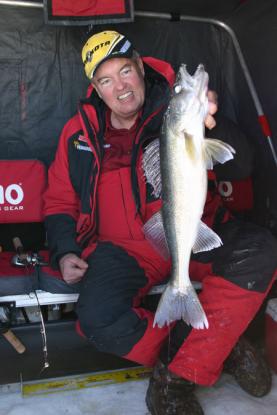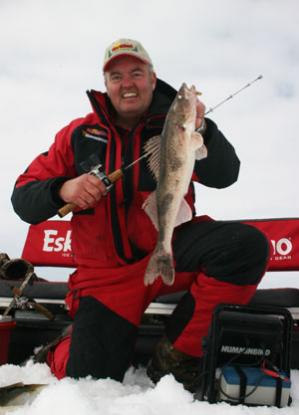 A lot of Lake of the Woods anglers are looking forward to the end of the ice fishing season and for good reason. Not that they want it to be over; it’s just that it’s so doggone good. There’s two real peak peaks to the hottest action and it’s early (like the first part of December) and late, including middle March to early April. With a Lake of the Wood’s special season closing date of April 14 you still have time to cash in on the fun, but supplies are limited. Ice conditions will determine how much of the late season anglers can take advantage of but safe ice generally lasts much later than most anglers would believe. Even with ice on the Twin Cities metro lakes giving in to warmer daytime temps there can still be safe ice to be had, especially if you get on the road and head a few hundred miles north. That extra distance can make a big difference on just how quickly the ice breaks down and becomes too dangerous to traverse.
A lot of Lake of the Woods anglers are looking forward to the end of the ice fishing season and for good reason. Not that they want it to be over; it’s just that it’s so doggone good. There’s two real peak peaks to the hottest action and it’s early (like the first part of December) and late, including middle March to early April. With a Lake of the Wood’s special season closing date of April 14 you still have time to cash in on the fun, but supplies are limited. Ice conditions will determine how much of the late season anglers can take advantage of but safe ice generally lasts much later than most anglers would believe. Even with ice on the Twin Cities metro lakes giving in to warmer daytime temps there can still be safe ice to be had, especially if you get on the road and head a few hundred miles north. That extra distance can make a big difference on just how quickly the ice breaks down and becomes too dangerous to traverse.
This season started a little late with the warmer November and early December temps. That combined with the early snow cover has kept ice from developing as thick as normal. Typically by now an auger extension is in order but probably won’t be necessary this time around. Another consideration is transportation, and snowmobiles are the rule if you plan on making a long distance run. You might be able to get by with a four wheeler but will depend on how much snow there is. The resorts will keep roads plowed close in until the end of March, when their houses have to be off the ice. If you’re fishing out of Baudette that means the Pine Island area which should be accessible, but a trip to an offshore reef like Knight, Bridges, or maybe Garden Island is going to require a sled or ATV. The longer runs are no fun on an ATV because they’re too darn slow and can be too darn cold. The reefs mentioned have a groomed snowmobile trail that you can run on most of the way out, and can really help speed up and smooth out the trip.
Solid numbers of walleyes and sauger are what’s in store for those willing to make the run to this monstrous northern border water. Besides the numbers there’s also a good chance for catching a real hawg, if you know where to look.
 When looking for fish don’t be afraid to head to shallow water, especially if you’re after walleyes. Late in the season sauger will typically hold in deeper water while walleyes move much shallower. It’s easy to fish too deep especially if you’re catching plenty of sauger, but that’s not the key to finding and catching walleyes. A good rule of thumb would be to start a little deep, say maybe twenty feet or so, and head shallower and shallower until you run out of fish.
When looking for fish don’t be afraid to head to shallow water, especially if you’re after walleyes. Late in the season sauger will typically hold in deeper water while walleyes move much shallower. It’s easy to fish too deep especially if you’re catching plenty of sauger, but that’s not the key to finding and catching walleyes. A good rule of thumb would be to start a little deep, say maybe twenty feet or so, and head shallower and shallower until you run out of fish.
Good late ice hot spots include just about all of the area along the break north of Pine Island out of Four Mile Bay. Walleyes and sauger will stage there before making a move into the river to carry on with the annual spawning ritual. They’ll stack up by the thousands and with that many fish concentrated in one area there are bound to be at least a few that will take a properly presented bait. You can also make a run for Garden Island or Knight and Bridges and has been “the place to be” the last couple of years and could easily be again. A GPS and an electronic map is another definite must and I would never leave home without it. You can try and get by with a handheld but it’s impossible to see all of that structure with a little screen. It’s also why I have a big screen Humminbird mounted to the dash of my sled. With a G.P.S. like the 788c (can also be mounted on your boat during the “off season”), you can plug in a Navionics or Lake Master chip and see the humps and bumps, the little inside turns, and the quick breaks where fish might stack up. With the big screen you can see where you want to go and navigate exactly to it with ease.
The same techniques that produced much earlier in the season can be expected to do the same now. That means using jigging spoons like Northand Tackle’s Buck-Shot or Macho Minnow tipped with a minnow, or set rigs with a shiner on a plain hook or small jig suspended beneath afloat, or a combination of both. Late season walleyes and sauger are generally active to enough to take a jigging bait and it doesn’t hurt to get a little aggressive with your presentation. A series of short hard snaps can help to attract fish, but it might take a steadier hand to trip their triggers. If you’re watching your bait on a depth finder like the Humminbird Ice 55, look for big wide marks that come in and move to the bait. If they don’t accept what you’re doing try changing it up until you find what they want.
There are tons of small walleyes and sauger everywhere so don’t let their presence fool you into thinking that you’re on the mother load. They’ll follow your bait up and down and usually not take it because it’s almost as big as they are. They’ll also get out of Dodge as soon as you give the bait a hard snap. About the only thing you can do is to forget about them and look for the larger marks that eventually show up. With the Ice 55 you can get a good idea of the size of a fish by the thickness of the red line. Big heavy lines deserve some extra attention and when they show up you definitely want to have your best foot forward. See you on the ice.










